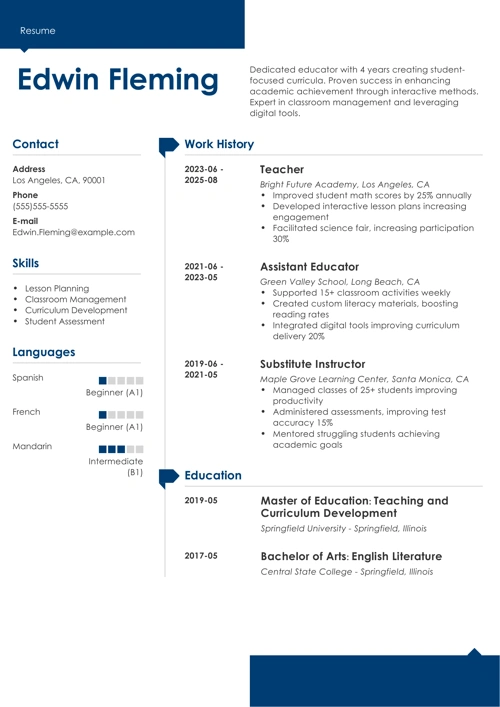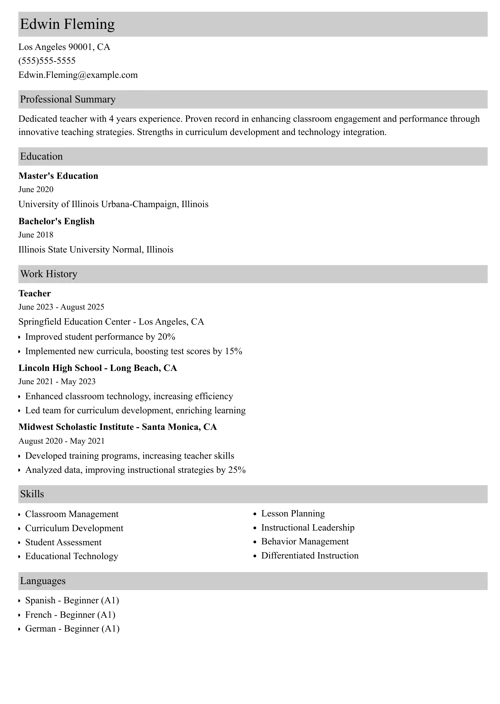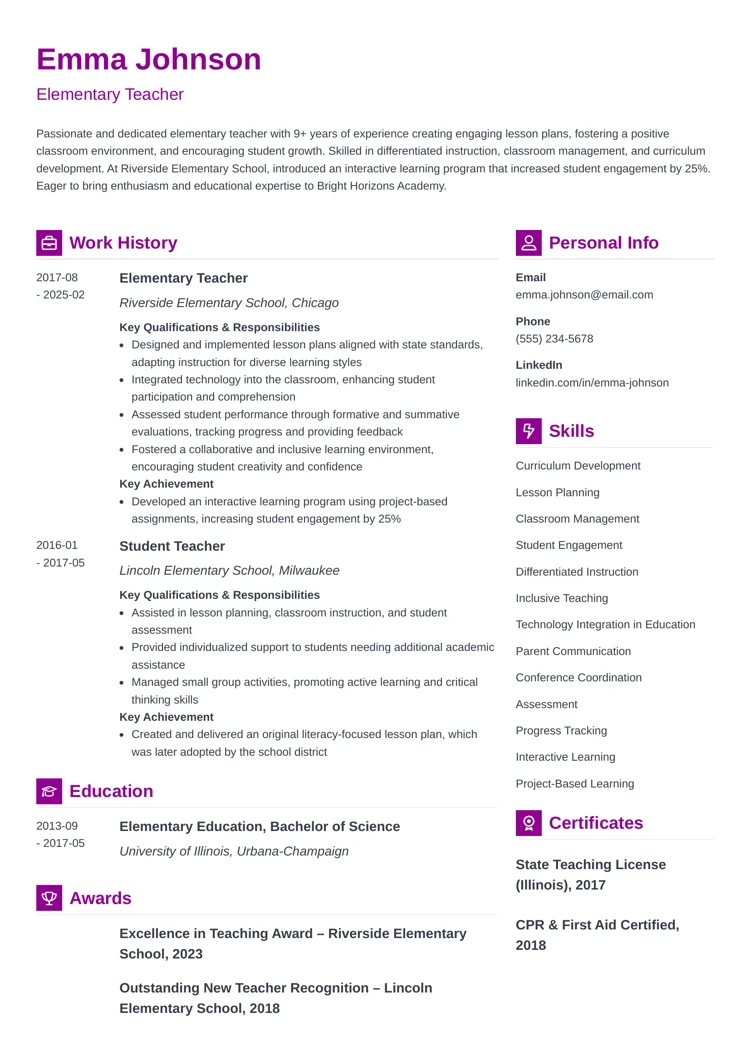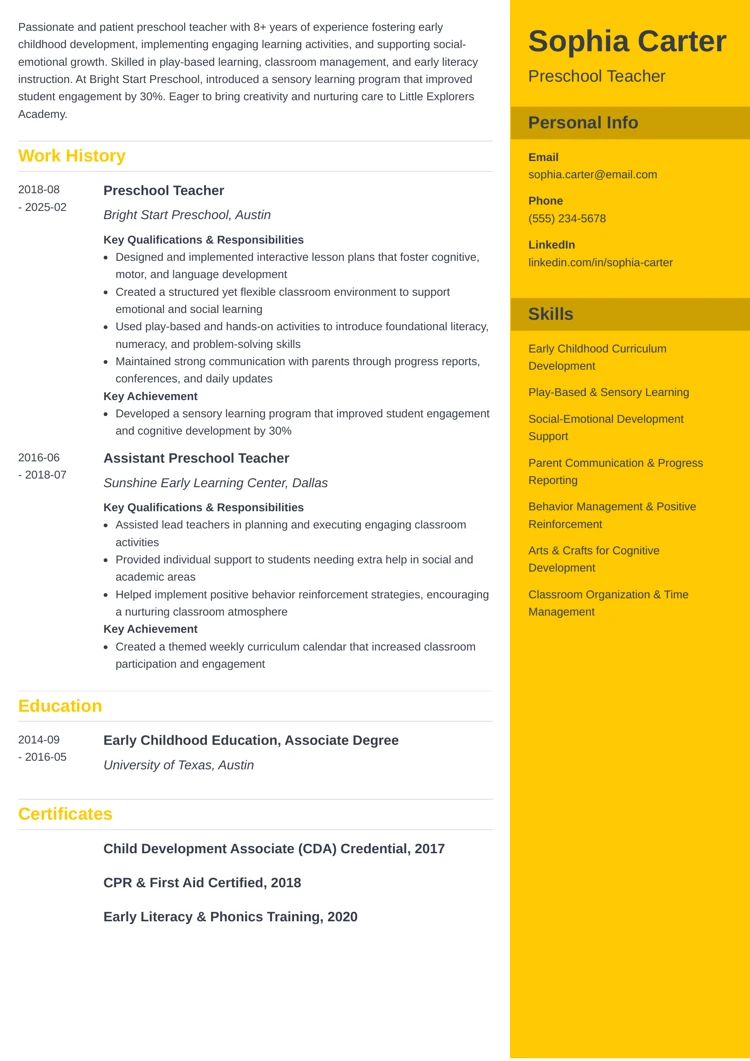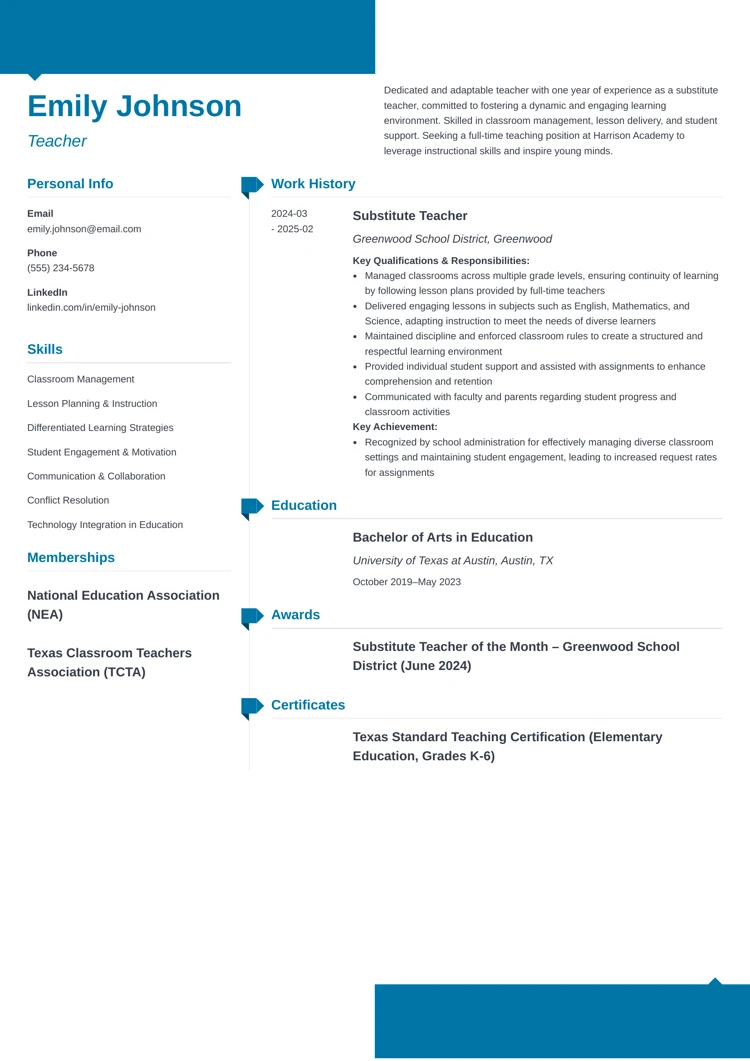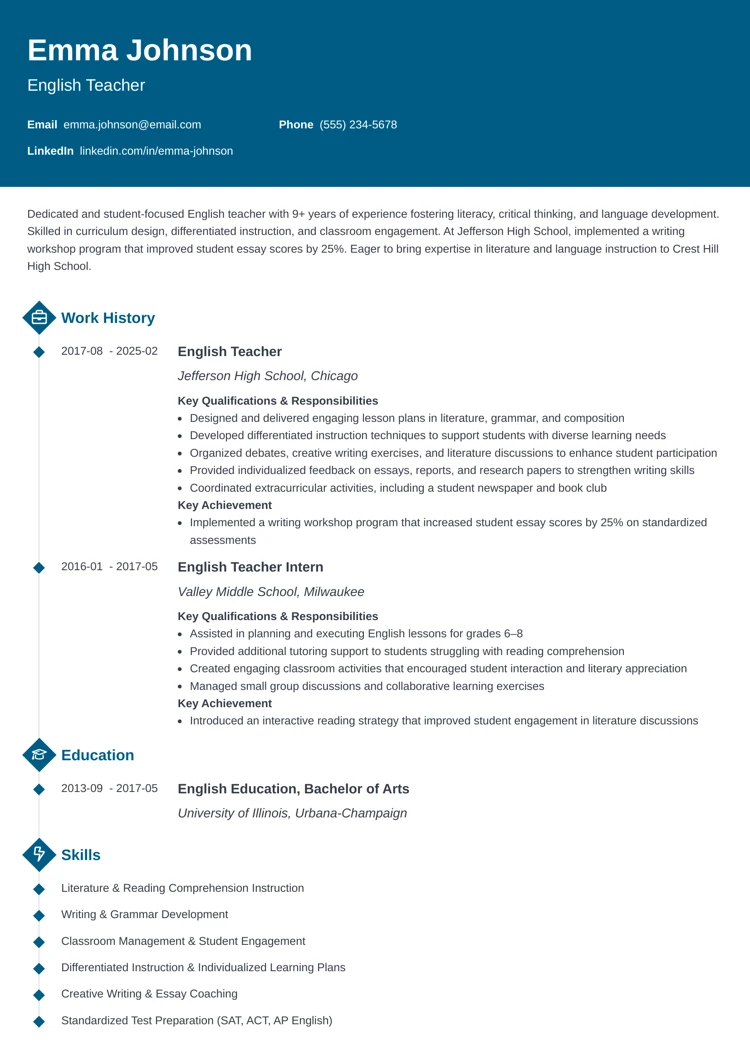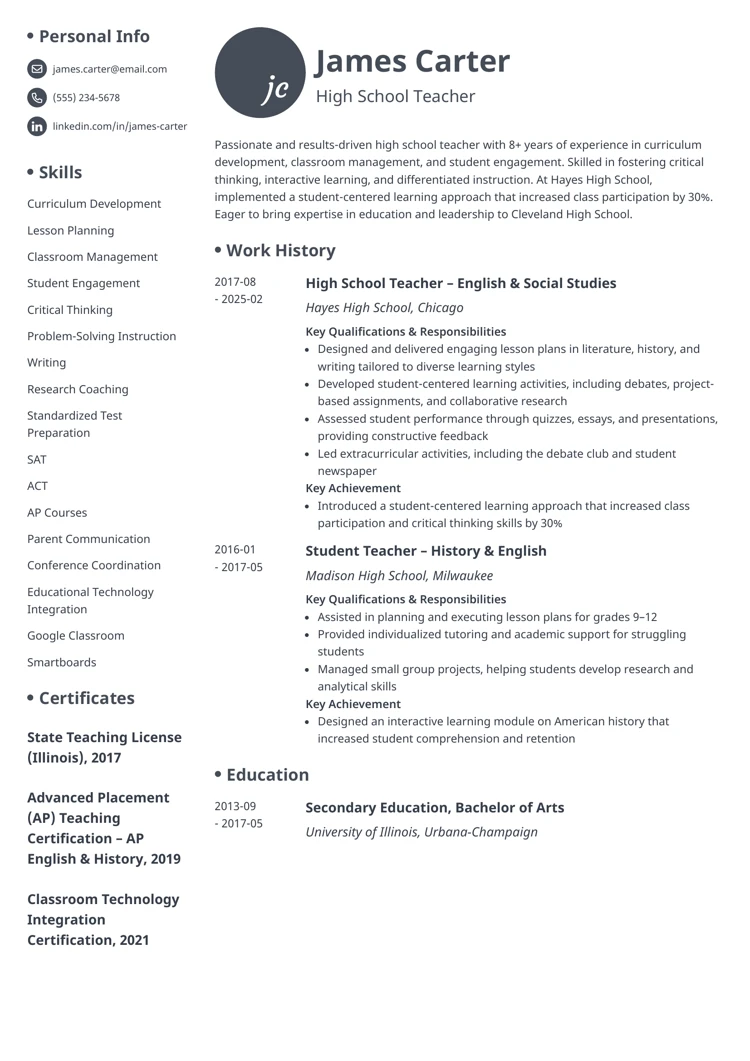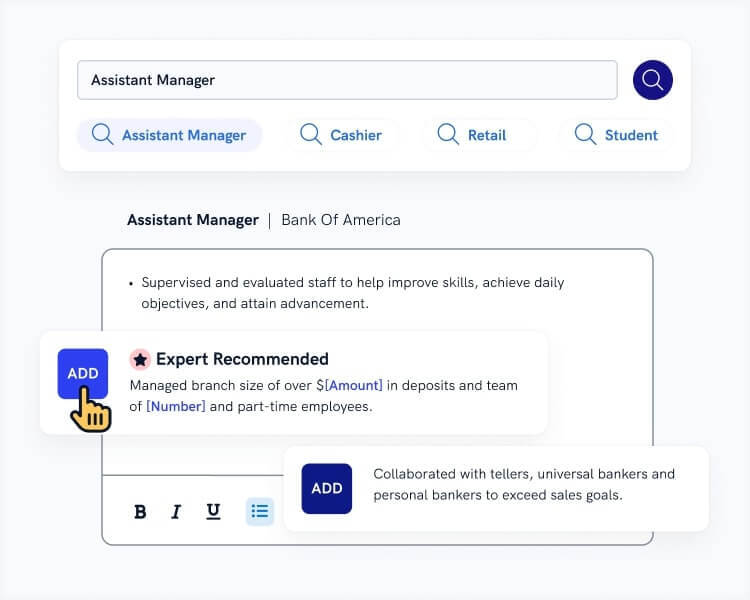You’ve got the teaching skills, the state certification, and the temperament to be a great educator.
Just one thing in your way—you need the best teacher resume to impress the school principal and showcase your educational talent. Wondering how to make a resume for a teacher that stands out? Use my expert-backed teacher resume examples and templates to craft a polished, professional resume with ease!
Top Article Insights:
- A sample teacher resume & template to copy & paste
- More resume examples for elementary teachers, new teachers, English teachers, etc.
- Step-by-step guide on how to write a teacher resume
Teacher Resume Example
Create Your Teacher Resume Now
Teacher Resume Template to Copy & Paste (Text Version)
Edwin L. Fleming
AZ State-Certified Elementary Teacher
602-352-3223
edwin.fleming@me.com
linkedin.com/in/edwinfleming
Summary
Compassionate and results-oriented elementary school teacher with more than 4 years of experience managing medium- and large-sized classrooms. Arizona State Educator License. Increased student pass rate by 32% in the 2018–2019 school year in classrooms with 30+ students. Seeking to leverage effective lesson planning and an empathetic attitude to become the next 4th-grade teacher at Joaquim T. Phillips Middle School.
Experience
Elementary School Teacher (3rd Grade)
Desert Trails Elementary School, Phoenix, AZ
September 2019–March 2025
Key Qualifications & Responsibilities
- Created and maintained a welcoming, friendly, engaging, and nurturing classroom environment where all students felt comfortable.
- Established classroom and field trip rules and enforced them fairly and effectively.
- Developed rigorous lesson plans and lectures and prepared students for quizzes and tests.
- Graded papers, lessons, tests, quizzes, and other assignments, relaying information to parents and school board when necessary.
Key Achievements
- Decreased student fail rate by 32% in 2021–2022 school year in classrooms with over 30 pupils.
- Teacher of the Year 2023
Kindergarten Teacher
Kyrene de la Sierra School, Phoenix, AZ
July 2018–August 2019
Key Qualifications & Responsibilities
- Designed and implemented an engaging curriculum for new public school students at the kindergarten grade level.
- Instructed 4-, 5-, and 6-year-olds on the alphabet, basic reading comprehension, and rudimentary mathematics.
- Assessed student performance through quizzes and testing, and provided one-on-one tutoring when necessary.
Education
Bachelor of Science in Elementary Education
University of Louisiana at Monroe, Monroe, LA
October 2013–May 2017
Relevant Coursework: Foundations of Education, Instruction for Elementary Students, Early Childhood Development, Language & Communication, Physical Sciences, Computer Literacy, Social Sciences, Classroom Engagement & Development, Special Education Theories.
Skills
- Classroom Management
- Lesson & Curriculum Planning
- Effective Communication
- Leadership Skills
- Compassion & Empathy
Courses and Certificates
- Arizona Educator Certification — Certification Unit at the Arizona Department of Education
Elementary Teacher Resume Example
What Do I Think About This Example? (Expert Tips)
A white background and black text— this simple yet elegant pairing is a perfect example of a teacher's resume. This creative resume template takes the best of both worlds—infographic resumes and traditional layouts—and blends them together seamlessly. This one's ideal for job seekers who prefer the reverse-chronological format. The well-structured column on the left is perfect for creating a timeline of your career journey.
Find out more about: Elementary Teacher Resume Example
Preschool Teacher Resume Example
What Do I Think About This Example? (Expert Tips)
What I like about this teacher resume sample is the bold use of color, which makes the entire document truly eye-catching. This creative resume template’s sidebar is placed on the right-hand side, stylishly highlighting your language proficiency and skills. We've also given the top header a sleek and minimalistic look so your name and title can take the spotlight.
Find out more about: Preschool Teacher Resume Example
New Teacher Resume Example
What Do I Think About This Example? (Expert Tips)
This modern resume template is perfect for teachers seeking a structured yet visually appealing format. I like how the left-hand sidebar neatly organizes skills and certifications while the main section highlights teaching experience and achievements. With its clean layout and clear sections, it ensures readability and professionalism.
Find out more about: New Teacher Resume Example
English Teacher Resume Example
What Do I Think About This Example? (Expert Tips)
I like how this attention-grabbing resume template offers a balanced layout which proves that less is more. The bold section headings improve readability, while the skill rating section quickly showcases your teaching expertise. The strategic placement of certifications ensures key credentials stand out, making this a polished and professional choice for all educators.
Find out more about: English Resume Example
High School Teacher Resume
What Do I Think About This Example? (Expert Tips)
A clean and structured template, ideal for high school teachers. The bold name header with initials adds a personal yet professional touch. The left-hand sidebar neatly organizes skills and certifications, while the main section highlights teaching experience effectively. In my opinion this template is an excellent choice for teachers looking to highlight both their experience and teaching philosophy in a structured, visually appealing way.
Find out more about: High School Resume Example
Looking for a different teaching position? Check these out:
- Substitute Teacher Resume
- Teaching Assistant Resume
- Special Education Teacher Resume
- Student Teacher Resume
- Art Teacher Resume
- Kindergarten Teacher Resume
- Yoga Teacher Resume
- ESL Teacher Resume Sample
- Math Teacher Resume
- Dance Teacher Resume
Creating a resume with our builder is incredibly simple. Follow our step-by-step guide and use content from Certified Professional Resume Writers to have a resume ready in minutes.
When you’re done, Zety’s resume builder will score your resume and our resume checker will tell you exactly how to make it better.
How to Write a Teacher Resume?
If the list of resume examples is not enough, here are some of my expert tips for writing a job-winning teacher resume (with examples). First, take a look at some of the teacher’s resume statistics based on the Zety builder:
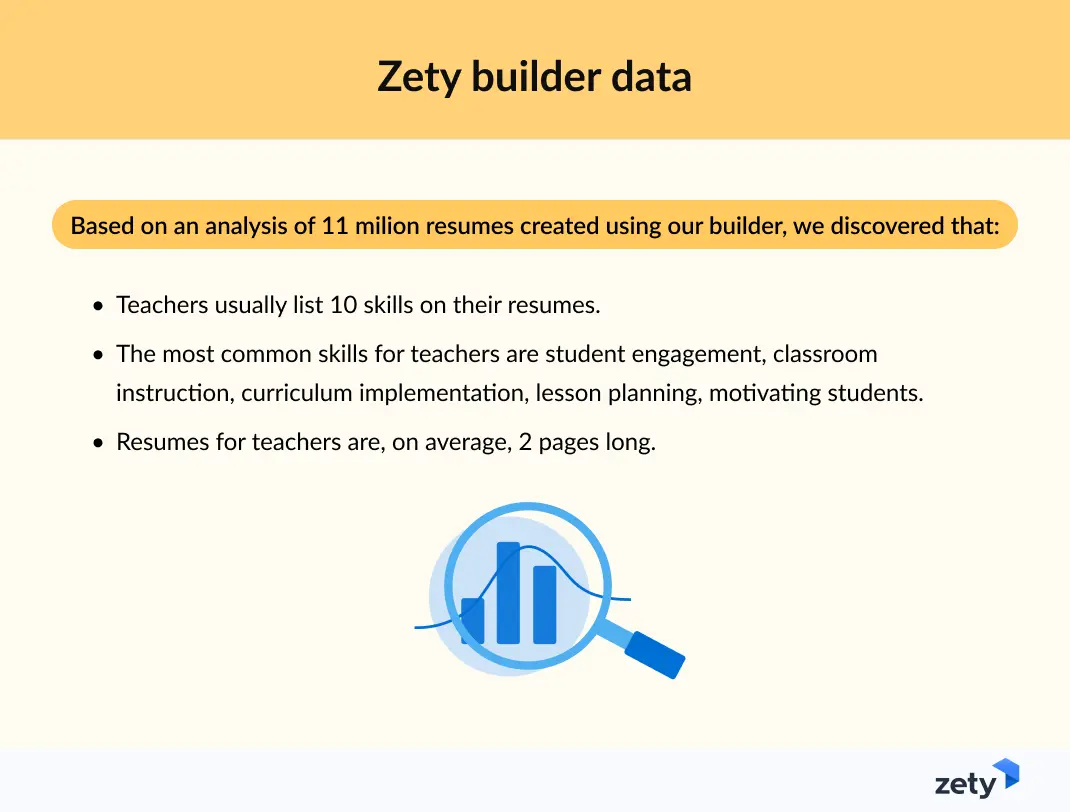
1. Start With the Right Format for Your Teacher’s Resume
With the job market becoming more competitive and the U.S. Bureau of Labor Statistics projecting a -1% decline for elementary school teachers and most types of other teaching positions between 2023 and 2033, it’s more important than ever to present a well-structured and polished resume.
Schools want teachers who are not only knowledgeable and experienced but also highly organized and detail-oriented. Your teacher's resume format should reflect these qualities at a glance. A poorly formatted resume can cause even the most qualified candidates to be overlooked, so ensuring clear organization, readability, and professionalism is key to standing out from other applicants.
How to format your teacher resume template:
- Resume Format: Use the reverse-chronological format to emphasize your most relevant teaching experience first.
- Fonts: Choose professional, easy-to-read fonts like Calibri, Georgia, or Arial.
- Spacing: Stick with 1.0–1.15 line spacing.
- Font size: Use 11–12 points for body text and 13–14 points for section headings.
- Margins Keep the margins on your resume1 inch all around.
- File type:Save your resume as a PDF unless the school requests a Word document.
Pro Tip: A one-page resume is ideal for teachers with less than 10 years of experience. More experienced educators may extend their resume to two pages.
2. Add Experience to Your Teacher’s Resume
According to recent data, 406,964 teaching positions nationwide were either unfilled or filled by educators without full certification, representing about 1 in 8 of all teaching positions. This means schools are actively seeking qualified candidates, and a strong resume can help you secure a competitive teaching role despite a slightly declining job outlook. Ensuring your resume clearly showcases your certifications, accomplishments, and classroom impact will help position you as a top candidate in the field.
Listing experience isn’t enough—you need to highlight your impact in the classroom. Instead of focusing only on duties, emphasize how you improved student learning outcomes and contributed to school initiatives.
How to structure your teaching experience:
- Start with your most recent job.
- Include the school name, location, and employment dates.
- Write a concise job description.
- Use bullet points to showcase key achievements.
- Demonstrate impact using the PAR (Problem-Action-Result) formula.
Elementary School Teacher (3rd Grade)
Desert Trails Elementary School, Phoenix, AZ
September 2019–March 2025
Key Qualifications & Responsibilities
- Created and maintained a welcoming, friendly, engaging, and nurturing classroom environment where all students felt comfortable.
- Established classroom and field trip rules and enforced them fairly and effectively.
- Developed rigorous lesson plans and lectures and prepared students for quizzes and tests.
- Graded papers, lessons, tests, quizzes, and other assignments, relaying information to parents and the school board when necessary.
Key Achievements
- Decreased student fail rate by 32% in the 2021–2022 school year in classrooms with over 30 pupils.
- Teacher of the Year 2023
Pro Tip: Quantify your achievements whenever possible to make your experience more compelling. For example, instead of writing: "Implemented a new reading program," write: "Implemented a new reading program that increased student literacy scores by 15% in one year." Numbers provide concrete proof of your impact and help your resume entice the hiring managers to contact you.
3. Make Your Education Section Shine
Your education goes beyond your degree—this section should highlight relevant credentials, coursework, and teaching certifications. Many schools require specific licenses and endorsements, so make sure to feature them prominently in your resume for teachers.
What to include in a teacher resume education section:
- Degree earned (e.g., Bachelor’s in Elementary Education)
- University name and graduation year
- Relevant coursework (for new teachers)
- Honors and distinctions (magna cum laude, Dean’s List)
- Certifications and licenses (if not listed separately)
Bachelor of Science in Elementary Education
University of Louisiana at Monroe, Monroe, LA
October 2013–May 2017
Relevant Coursework: Foundations of Education, Instruction for Elementary Students, Early Childhood Development, Language & Communication, Physical Sciences, Computer Literacy, Social Sciences, Classroom Engagement & Development, Special Education Theories.
Read more: Listing a Degree on a Resume: Expert Tips
4. Highlight Relevant Teacher Skills on Your Resume
Teaching is about more than just delivering lessons—it’s about engaging students, adapting to different learning styles, and fostering an environment where they can thrive. A strong teacher resume must highlight both hard and soft skills that make you an effective educator.
Check out these examples of the most essential skills for teacher resumes:
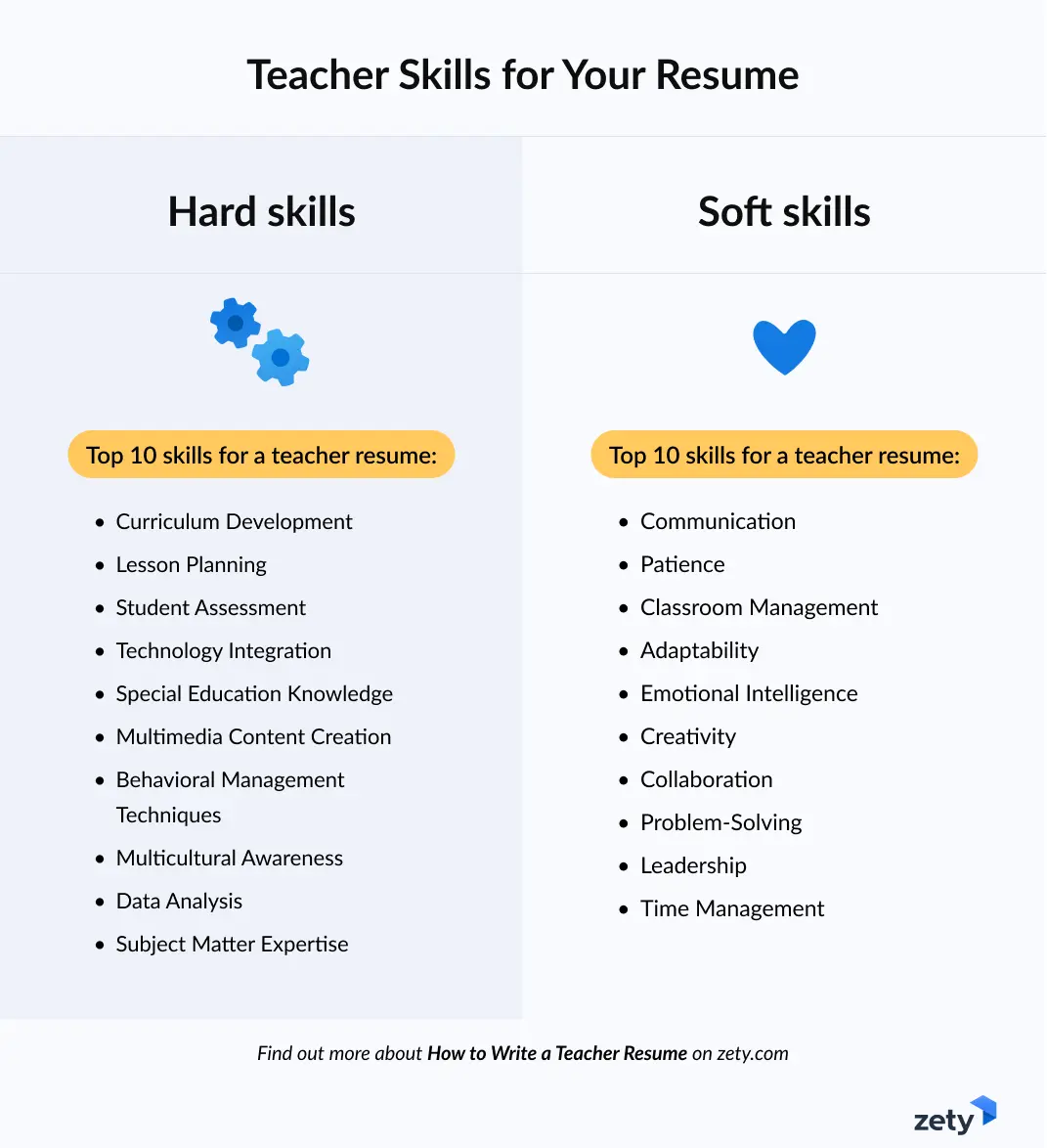
Pro Tip: Check the school’s website or LinkedIn to see what teaching approaches they prioritize—this will make it easier to select the most relevant skills for your teacher's resume.
5. Add Extra Sections to Strengthen Your Teacher's Resume
Beyond education and experience, including extra sections such as relevant certifications, professional development, and extracurricular involvement can make your resume for a teacher job stand out. Schools appreciate candidates who go the extra mile to contribute to the community and professional growth.
If you need some inspiration on what additional sections to include in your teacher resume, then check out the examples below:
- Certifications & Licenses:
- State Teaching License
- TESOL or ESL Certification
- Special Education (SPED) Certification
- Extracurricular Activities:
- School Soccer Team Coach
- Drama Club Advisor
- Foreign Languages:
- Spanish (Fluent)
- French (Basic)
- Professional Development:
- National Educators Conference (2023)
- Classroom Technology Workshop
- Volunteer Experience:
- Tutored underprivileged students at a community center
When it comes to listing language proficiency, it's important to be honest about your abilities. Overstating your fluency can backfire in an interview or on the job. Instead, clearly define your skill level using standardized terms. You can also give examples of how you’ve used the language professionally.
6. Write a Strong Teaching Resume Summary or Objective
A compelling resume profile acts as a snapshot of your teaching qualifications, summarizing your teacher's resume skills and career highlights in a few sentences. A strong resume profile is one of the most effective ways to grab and hold the attention of a potential employer.
How to write an engaging resume profile:
- Start with an adjective (e.g., passionate, dedicated).
- Mention your job title (e.g., Elementary Teacher).
- State your years of experience.
- Highlight a key achievement.
- End with how you can benefit the school.
Passionate elementary school teacher with 5+ years of experience creating engaging lesson plans and improving student test scores by 20%. Skilled in integrating technology and differentiated instruction to accommodate diverse learners. Excited to bring innovation and enthusiasm to Oakwood Elementary School.
Pro Tip: For maximum impact, your resume profile should be adjusted to your level of professional experience. If you’re just starting out in the world of education, write a resume objective. Do you have at least two years of experience? A resume summary will be a better choice.
7. Write a Job-Winning Teacher Cover Letter
A resume gets your foot in the door, but an excellent cover letter is what truly sets you apart. Schools want teachers who are passionate about education, and your cover letter is the perfect place to express your teaching philosophy and enthusiasm for student success.
Even the best teacher resume templates cannot fully convey your personality, dedication, and unique teaching approach. A tailored cover letter allows you to connect with hiring managers on a more personal level, demonstrating why you are the perfect candidate for their school.
How to structure your teacher's cover letter:
- Start with the hiring manager’s name (e.g., “Dear Principal Smith”).
- Write an engaging opening that hooks the reader and highlights your passion for teaching.
- Emphasize key teaching achievements that align with the school’s needs.
- Showcase your commitment to student success by discussing your approach to lesson planning, classroom management, and student engagement.
- End with a strong closing and a call to action, such as requesting an interview or expressing your enthusiasm for the opportunity.
Example opening sentence:
Dear Principal Smith,
I believe every child deserves a chance to love learning. As a passionate elementary school teacher with five years of experience, I have helped students improve their reading skills by 30% using innovative teaching methods. I’m excited to bring my expertise to Jefferson Elementary School.
Pro Tip: Your cover letter should be customized for each application. Schools appreciate candidates who demonstrate a strong understanding of their specific values, teaching philosophy, and curriculum.
Plus, a great cover letter that matches your resume will give you an advantage over other candidates. You can write it in our cover letter builder here. Here's what it may look like:
See more cover letter templates and start writing.
Expert Curated Video Content
If you prefer watching, our Certified Professional Resume Writer Caio, will explain to you in detail how to write a teacher's resume in 5 minutes!
About Zety’s Editorial Process
This article has been reviewed by our editorial team to make sure it follows Zety's editorial guidelines. We’re committed to sharing our expertise and giving you trustworthy career advice tailored to your needs. High-quality content is what brings over 40 million readers to our site every year. But we don't stop there. Our team conducts original research to understand the job market better, and we pride ourselves on being quoted by top universities and prime media outlets from around the world.
Sources
- Learning Policy Institute, "State Teacher Shortages 2024 Update”
- U.S. Bureau of Labor Statistics, "Kindergarten and Elementary School Teachers: Occupational Outlook Handbook"
- U.S. Bureau of Labor Statistics, "Middle School Teachers: Occupational Outlook Handbook"
- U.S. Bureau of Labor Statistics, "High School Teachers: Occupational Outlook Handbook"
- U.S. Bureau of Labor Statistics, "Postsecondary Teachers: Occupational Outlook Handbook"
